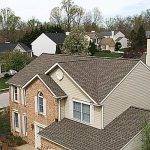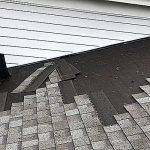Most homeowners rarely ever think of their attics, because most of the time they are only used for storage, and nothing more. But homeowners should be more aware of what goes on in their attic. Proper attic ventilation is necessary for a functioning home, and can save you a lot of money and hassle in the long run. Below, we will explain what soffit vents and ridge vents are, and how they can improve your home.
What Is a Soffit Vent?
A soffit vent is a vent that is located on the underside of a home’s eaves, which are the overhanging edges of the roof. The soffit vent screen allows fresh, cool air to flow into your attic from under your eaves. Soffit vents can help reduce moisture and heat buildup in your attic, which helps prevent problems like mold, mildew, and rotting wood.
To get a full picture of how ventilation fits into your overall roof structure, check out our overview of the parts of a roof system.
Comparing a Vented Soffit to a Non-Vented Soffit
As explained above, the soffit is located on the underside of your home’s eaves. While most new homes have vented soffits, many older homes have non-vented soffits. A vented soffit has holes, which allows air to enter into the attic, while the non-vented version is solid and keeps all air out. A soffit that is non-vented will keep your house warmer, which will put you at a disadvantage, especially during the hot and humid Maryland summers. If you do not have a vented soffit and are thinking about installing one, reach out to an expert for a professional opinion.
Related: Difference between a Gable, Soffit and Ridge Vent
If your home has a vented soffit, make sure that your baffles are working properly. A baffle allows the air that is coming through the soffit to go all the way up into your attic. If you do not have a baffle, all of the air will get trapped in the outside area, which defeats the purpose of having a ventilation system. For more information on vented and non-vented soffits, check out the video below.
Benefits of a Ridge Vent
A ridge vent is a common roof ventilation option, and is a vital part of your home’s ventilation system. It is located at the top of a sloped roof, and allows warm, damp air to leave the attic. Without a ridge vent, the air would be left trapped in the attic, which could cause a number of problems, such as cracking and premature aging. A ridge vent that is properly installed and functions as intended will prolong the life of your roof and increase your home’s energy efficiency.
When discussing ridge vents and how hot air escapes, you might also reference ridge vents vs. attic fans for a deeper look at exhaust-vent options.
Do You Need Soffit Vents with Ridge Vents?
Yes, soffit vents are typically necessary when using ridge vents to ensure proper attic ventilation. Together, they create a balanced ventilation system that allows air to flow efficiently through the attic space.
Your intake vents are just as important: learn more about how gable, soffit & ridge vents differ and work together.
How Ridge Vents and Soffit Vents Work Together
Soffit Vents allow air to enter the attic from under the eaves. The air then rises to the top of the attic. Without proper ventilation, the air will have a hard time escaping, which is where the ridge vent comes into play. A functioning ridge vent will allow the hot air to escape through the roof. The air comes in through the soffit vent, and exits through the ridge vent. It’s as simple as that. A ridge vent without soffit vents won’t work as intended, and vice versa.
Exceptions or Alternatives
If soffit vents are not feasible, other intake vents (such as gable vents or edge vents) can sometimes be used. However, soffit vents are generally the most effective intake option when paired with ridge vents.
To ensure your system is effective, you can examine your attic’s ventilation and check that the intake (soffit vents) and exhaust (ridge vents) are working correctly.
Don’t forget: roof penetrations affect airflow too — here’s what you should know about pipes on your roof.
Want To Learn More About The Structure Of Your Roof?
Want to go further? Whether you’re installing new intake/exhaust systems or managing rooftop equipment, the correct flashing and vent-integration are critical. Explore our guide on how to install flashing around a vent pipe and get detailed insight into roof-mounted HVAC systems to ensure your roof’s ventilation works the way it should.
Are You Looking for a Maryland Roofing Company?
If you are looking for a roofing company in Maryland, RoofPRO has you covered. To get a free estimate or to learn more information, give us a call at (410) 453-1665. We look forward to hearing from you.



